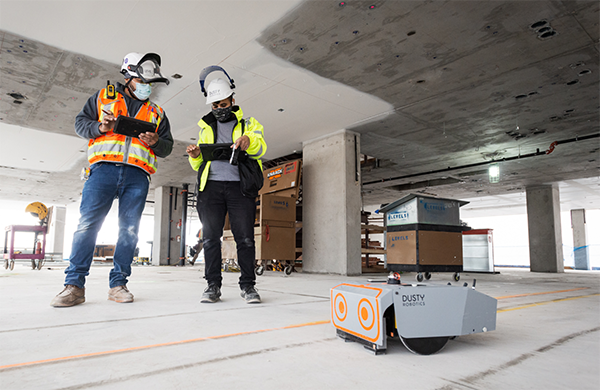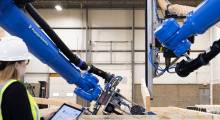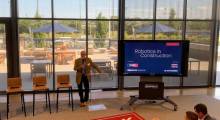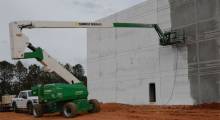The construction industry is a promising growth area for robots, drones, and autonomous vehicles. Dusty Robotics today said it has closed Series A funding of $16.5 million, which it plans to use to expand its team and meet customer demand.
The global construction industry has grown 9% during the past year to $12 trillion, estimated Research and Markets. By 2025, it will generate nearly $17 trillion, said the research firm. However, construction is one of the most fragmented and least digitized industries, noted Dusty Robotics. Each project relies on a complex web of skilled subcontractors to complete individual components. As a result, two-thirds of large projects finish behind schedule, and half go over budget, according to Dodge Data & Analytics.
“The construction industry is in the midst of a digital transformation. Most projects have adopted building information modeling (BIM) to design buildings in full 3D, yet layout crews still use paper plans, measuring tape, and string to transfer those designs to the site for construction,” stated Tessa Lau, co-founder and CEO of Dusty Robotics. “We are creating a future where robots are standard tools used to construct every building, turning BIM into reality, and eliminating the errors that create waste.”
FieldPrinter rapidly realizes BIM
Founded in 2018 by serial entrepreneurs, Dusty Robotics has developed tools to accelerate the digital transformation of the construction industry. The Mountain View, Calif.-based company's first product is FieldPrinter, an autonomous robot that prints plans from building information models directly onto the floor, automating one of the most manual processes on job sites.
The robot lays out floor plans up to 10 times faster than traditional crews while guaranteeing accuracy up to 1/16 of an inch, claimed Dusty. FieldPrinter prints “IKEA instructions” directly on the floor that instruct crews exactly what to build where, it added. By eliminating layout delays, errors, and rework, the mobile robot can help keep projects on time and on budget, said the company.
Were there any challenges in adapting different building information models for FieldPrinter?
“BIM is quickly becoming a standard across the industry,” Lau told Robotics 24/7. “The majority of projects are designed and coordinated in BIM. What our product does is increase the value of those 3D models by bringing them out into the field so that crews can build directly off the model.”
“We're now on our third-generation hardware design, which incorporates a ton of learnings from early user feedback and experience in the field,” she added. “As one example, our first prototype placed the printing mechanism in the center of the robot. We quickly discovered that we needed to be able to print close to obstacles, so we redesigned the print system to have a printer that can extend out to the side of the robot so we can print about 1 in. from walls or other obstacles.”
Pandemic increases interest in robots
How did the COVID-19 pandemic affect the construction industry and demand for Dusty Robotics' Field Printer?
“The pandemic increased interest for FieldPrinter,” said Lau. “With social distancing measures in place, construction companies realized that robots could help them safely increase the productivity of the limited teams who were allowed on sites. Construction companies are always looking for tools to help on-site teams be more productive, precise, and effective, and the pandemic simply accelerated demand for automation that had already been percolating for some time.”
“FieldPrinter enables layout crews to complete their work at least five times faster than traditional, manual layout, with the assurance of 100% accuracy,” she said. “This allows contractors to speed up schedules and conduct less rework at the end of the project, so they clearly saw the benefit of our robot during the pandemic.”
How many sites has FieldPrinter been on in the past year or so? “Since FieldPrinter launched commercially in mid-2020, we've completed over 1 million square feet of commercial production layout, across dozens of projects,” Lau said. “Two examples of projects where FieldPrinter was used are the 5M residential and office tower in San Francisco and the Climate Pledge Arena in Seattle.”
She noted that customers have seen significant time and monetary savings.
“We completed a 13-story multifamily residential project early this year,” said Lau. “Our client budgeted five days in the schedule for layout, and we were able to bring that down to a single day. Across all the floors of the project, this adds up to a significant time savings for a critical-path task.”
Some of Dusty’s early customers include Swinerton, DPR Construction, Build Group, and Pankow Builders.
“Through a R&D partnership with Dusty Robotics, we have successfully used FieldPrinter on building projects in Los Angeles; Austin, Texas; and Leesburg, Va., and we are excited about the possibilities of deploying FieldPrinter more widely,” said Bardo Ponce, operations manager at Swinerton. “Every project we bring Dusty to is seeing great strides in productivity, and we look forward to every iteration of this robot and the positive impact it will have on our industry.”
Funding to fuel Dusty Robotics growth
Canaan Partners, a venture capital firm with $5 billion under management, led the Series A round. It was joined by returning investors NextGen Venture Partners, Baseline Ventures, Root Ventures, and Cantos Ventures. The financing brings Dusty Robotics’s total funding to date to $23.7 million.
“With increasing digital adoption in the full commercial real-estate lifecycle, and especially the value created by using technology such as digital twins in the design and construction process, we believe now is the time for Dusty,” said Rich Boyle, general partner at Canaan. “These technologies have enabled construction to be more precise than ever before and have opened the door to completely re-imagining the complex and time- and labor-intensive layout process.”
Lau said that Dusty Robotics will use its latest funding to scale up to meet customer demand.
“We've seen a large amount of demand from potential customers, which are mostly general and specialty contractors and real estate developers from all around the world, so we will use the funding to build more robots to service this demand,” she said. “We will also greatly expand our team.”
About the Author
Follow Robotics 24/7 on Linkedin
Article topics
Email Sign Up

















